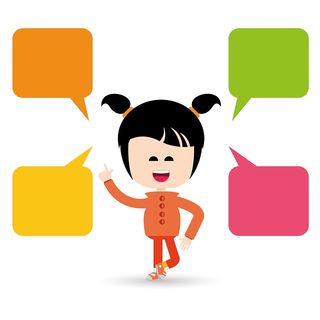Relationships
What's in a Word?
A child's first word is a celebrated milestone, but can be hard to identify.
Posted February 21, 2020
Identifying a child’s first word can be an important and often-recited piece of family lore. I was a child language researcher before I was a parent, and when my oldest child started to babble I looked forward eagerly to hearing her first word.
I had read that children “should” be saying their first word around their first birthday and start combining words by their second birthday. This was a concise and easy-to-remember milestone, and I was sure that I would recognize it in my own child.
As her babbling progressed, I listened carefully… and realized I wasn’t even quite sure what to listen for! Does a “moo” count when she sees a cow? How about clearly saying “dada” when she points to her dad, but also when she points to me, her doll, a stranger, or a dog?
Recently a friend asked me what “counted” as her child’s first word: he was using some babbling, some signs with his hands, and some animal noises. I was reminded of that confusing point in my own child’s language development—when I felt like I was waiting with pen uncapped and notebook at the ready for that precious first word to reveal itself.

What is a word, after all? Words in our native language are so closely tied to their meanings that it’s hard to separate them. The word "book" immediately brings to mind a concept of, well, a book! However, so does the word "libro," if you speak Spanish. The sounds made when we pronounce "book" and "libro" are equally good ways of referring to the concept of book, and there are many, many others. There are even numerous manual ways of referring to "book" in the various sign languages of the world. So, what is it that makes the sound "b-o-o-k" refer to the concept of a book? Simply the fact that we, as English-speakers, agree on that connection! "Book" is an arbitrary sound to refer to the concept of a bunch of printed pages bound together.
The fact that words have an arbitrary relationship to the concepts they represent means that they are symbols. A symbol stands for something that it is not like (summarized in Golinkoff et al., 2000). "B-o-o-k" is unlike a bound volume of pages. "B-a-b-y" is unlike a small human. "L-o-v-e" is unlike the feeling you have when you see your favorite people. "J-u-s-t-i-c-e" is unlike the concept of fair treatment and equality. These are all symbols that English-speakers have agreed stand for those objects or concepts. Speakers of other languages have come to completely different agreements on what symbols stand for those concepts. (We would have to ask a historical linguist if we wanted to understand how those words first came to stand for those concepts and how they evolved to their current pronunciations.)
We have other ways of referring to objects and concepts—for instance, pictures and charades. A picture, whether as realistic as a photograph or as stylized as a cartoon, looks like the thing it refers to. A picture of a book is like a book. A speaker of another language would recognize that picture as a book, even if they used a different word to label it. I could put my hand up to my mouth and make a chewing sound, and people could assume I was referring to the concept of eating. That action is like eating.
So, when does a babble or gesture start being a symbol? When does it start standing for something else? I looked for my daughter to consistently refer to something using the same sound. Still not so easy—does it count that she said something that sounded like “baby” while looking at her doll, twice, and then didn’t say it again for several months? Or should I count the fact that she stopped referring to anything besides her dad as “dada” a few months after she turned one? And what should I tell my friend, whose one-year-old is signing with his hands as well as making verbal babbles that are recognizable to her and her husband, but no one else?
I’ve decided to relish the fact that our children are capable of acquiring these arbitrary symbolic relationships, and just pick one to pass on as family lore.
And I won’t hold it against my daughter that it took her months and months past her first birthday to finally… finally use the symbol “mama.”
References
Golinkoff, R. M., Hirsh-Pasek, K., Bloom, L., Smith, L. B., Woodward, A. L., Akhtar, N., Tomasello, M., & Hollich, G. (2000). Becoming a word learner: A debate on lexical acquisition. New York: Oxford University Press.


